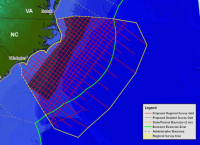BEAUFORT – To put this in some kind of human frame of reference: Imagine a crowded bar and a bad rock band so loud you can’t make a pass at the girl on the bar stool next to you. Doug Nowacek, a marine ecology and bioacoustics expert at the Duke University Marine Laboratory in Beaufort, is pretty sure that’s what whales and other sea creatures that rely on sound to communicate or navigate are faced with when high-decibel sound waves are used in the ocean to test for oil and natural gas.
Further, Nowacek and other experts said in a recently published paper, that the sounds from seismic guns can “mask” the sounds that whales and other creatures in the water rely upon to navigate, find food and avoid predators. And research increasingly indicates that’s not just a short-term problem; long-term exposure – and seismic testing can go on for months, 24 hours a day, seven days a week – can cause severe stress and disorientation.
Supporter Spotlight

Think about living beside a jackhammer that doesn’t stop hammering. What would you do? Move? And what if that jackhammer is in the area where your main food supply is located, or in the hospital room where you’ve gone to give birth?
All of this, Nowacek and the other authors say in the paper points to the need to monitor and control seismic testing like other kinds of pollution. Joining Nowacek are scientists from Cornell University; Humu Labs, a Massachusetts-based company that sells computer platforms for researchers; the University of St. Andrews; the Wildlife Conservation Society; the Natural Resources Defense Council; the University of California at Santa Cruz; and Southall Environmental Associates.
Published in the September issue of Frontiers in Ecology and the Environment, the paper says that the need for worldwide monitoring and controls is becoming more obvious because we’re opening up new waters – the Atlantic, for example, and the Arctic, where sea ice is rapidly melting – not only to seismic testing, but also to noisy shipping.
In a nutshell, the paper states that:
- Marine seismic surveys produce intense sound impulses to explore the ocean floor for energy sources and for research purposes;
- Environmental reviews of seismic surveys are seldom undertaken at scales necessary to meaningfully assess, mitigate and monitor their impacts;
- Managing exposure of marine animals to these sounds requires additional attention and data;
- Current exposure threshold criteria fail to account for the best available science and the cumulative effects of simultaneous seismic surveys and prolonged, repeated exposures;
- Increasing marine seismic surveys, especially in ecologically sensitive areas, require multi-institutional and international collaboration to effectively manage risks; and
- Ocean noise should be addressed by revising an existing treaty on ocean pollution or negotiating a new one that more comprehensively evaluates the associated risks, benefits and procedures.
A key problem, Nowacek said in a recent interview, is the arbitrary decibel level the federal government uses to assess the likelihood of a sound or sounds harming marine mammals.
Supporter Spotlight
“They say 160 is harmful but 159 is not,” he said. “And each decibel is a magnitude of 10. We know that the bowhead whale, a cousin of the (endangered) right whale starts responding at 95 decibels.”

Right whales pass through the area where there is likely to be seismic testing off the Carolinas, Nowacek said, and they do so after giving birth in waters of Georgia and Florida. The mother and the young stay close together in the calving grounds, but not much is known about how close they stay together as they move north. But if they are far enough apart, and their communications are made impossible by seismic or other noise, Nowacek said, the calves’ chances of survival “are low,” like the chances of any nursing mammal separated from its mother.
What’s the chance of that happening? “Is it 50 percent? More?” Nowacek asked rhetorically. “Maybe, maybe not. But we don’t know.”
The point, he said, is that all the experts know for sure that decibel levels at 160 or above can be and likely is harmful, but not so much is known about the impacts of exposure of lower decibel levels, especially over an extended time period. The 160-decibel threshold has been traced back to 1999, Nowacek added, and while there’s no doubt it was an attempt to find a reasonable number at the time, it’s 16-year-old science, at best.
He cited effects on other mammals at decibel levels below 160:
- Harbor porpoise feeding buzzes decreased 15 percent with exposure to seismic air guns at 130–165 decibels.
- Blue whale call rates increase with exposure to seismic “sparkers” at 140 decibels.
- Fin whale call rates decrease and migratory disruption occurs when exposed to seismic air gun surveys at 175 to 285 kilometers distance at noise levels below shipping noise.
- Seismic survey activity disrupts the breeding display, or singing, of humpback whales.
- Blue whales ceased calling upon exposure to air gun signals of 143 decibels.
And with at least five companies seeking seismic permits for waters off North Carolina, it’s almost certain that testing would go on 24 hours a day, seven days a week, for months. Further, Nowacek said, the area thought to be the most popular spot for testing, and the most likely spot for drilling off North Carolina – east of Cape Hatteras – is also one of the largest gathering points in the world for marine mammals, sea turtles and birds.

“None of us (authors of the paper) are Chicken Littles, running around saying the sky is falling,” Nowacek said of himself and his co-authors. Rather, they’re saying that lower decibel levels likely have impacts that at least result in “harassment” of the mammals, and harassment at the very least is potentially harmful.
In practical terms, what this would mean, according to Nowacek, is that the impact circles – the size of the zone around the seismic ships in which impacts are likely, would be larger at a lower decibel level. And that means more mammals would likely be within those circles at any given time.
At the very least, the paper states, “An integrated program for monitoring, mitigating, and reporting would facilitate development of a knowledge-based understanding of potential risks and solutions; the establishment of such a program would necessitate coordination and prudent planning. Efforts to monitor the undersea acoustic environment and manage the impacts of noise generated by human activities have reached a critical juncture.”
The European Union, the paper notes, recognizes ocean noise as an indicator of environmental quality and is in the process of developing targets for achieving “good environmental activities.”
Nowacek and other marine mammal experts, including fellow Duke researcher Andy Read, included some of the concerns expressed in the paper in their official comments to the National Marine Fisheries Service, which is evaluating the seismic companies’ applications for permits. In particular, they stressed the need for NMFS to consider cumulative impacts.
And in the paper, Nowacek and his co-authors recommended a framework that in the future would make such considerations the norm.
“Given the transboundary scale and numerous sources of anthropogenic sound in the world’s oceans – including noise from marine seismic surveys, which are ubiquitous and increasing in abundance – we believe that a responsible path forward should focus on the creation of legally binding international commitments,” they wrote. Successful precedents mostly involve international protocols and conventions for air pollution and or pollution from ships, they wrote, but “various international authorities, such as the convention on Biological Diversity and Convention on Migratory Species, now classify ocean noise as a pollutant.”
As for now, he said, President Obama and the U.S. Secretary of the Interior, Sally Jewell, have the authority to remove specific areas from the list of waters whether seismic testing and oil and gas production are allowed, and did so in Alaska, in 2014.
The administration removed more than 52,000 square miles of Bristol Bay and nearby waters – an area roughly the size of Florida – that the president called one of the country’s great natural resources, “something that’s too precious for us to be putting out to the highest bidder.”
While everyone realizes that for some time into the foreseeable future, some oil will be necessary, Nowacek said, there’s currently a glut, and the president and the interior secretary could clearly make the same assessment and decision about some Atlantic waters, including the area off Hatteras in North Carolina.







